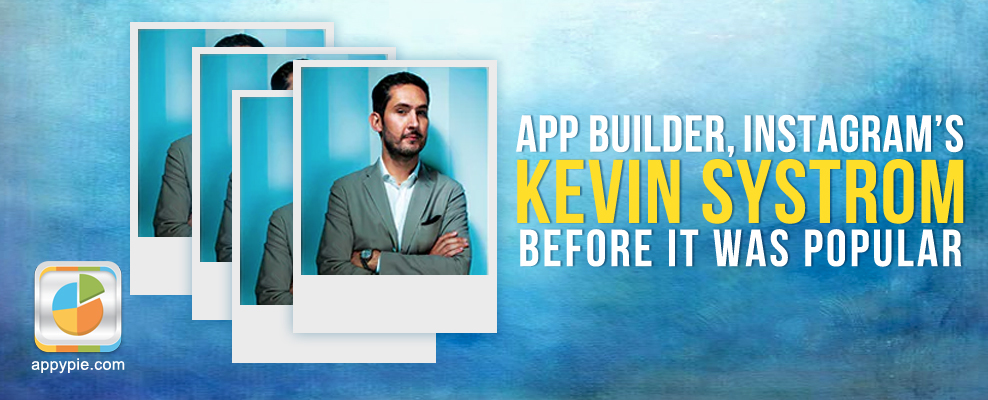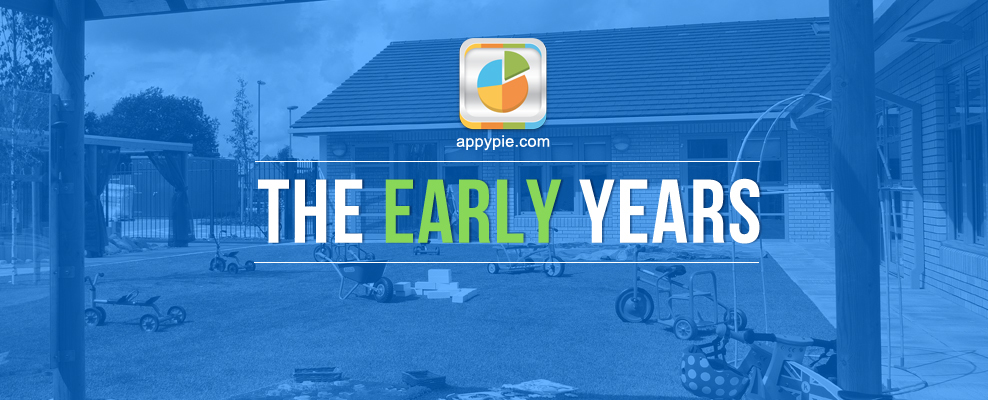App Builder, Instagram’s Kevin Systrom, Before It Was Popular

App Builder Appy Pie, Aug 23: Mobile apps have transformed the way how we live, eat, exercise, socialize, work, learn, entertain, and play. Apps like Uber, WhatsApp, Airbnb, Snapchat, etc., have amazing impact on our lives. When it comes to customer services, Uber has greatly exceeded customer expectations in terms of quality and level of service. WhatsApp has changed our lives forever by making communication more effortless than before. And finally one of the most loved apps nowadays, Instagram has changed the way we click and share photographs.
Initially, the app builders behind these popular brands had no clue whether their apps would be welcomed by users or not. But, today the tables have turn around, and these successful apps are creating a great impact on the entire world, while giving a bright future to app industry. And, the same is true for Kevin Systrom, the app maker who built Instagram from scratch.
The Early Years
Kevin Systrom was born in Holliston, a small town in the Greater Boston area. His mother was a marketing executive at Monster, while his father was the Vice President (HR) at TJX Companies. Systrom’s interest in technology started from his childhood when he created his own levels while playing Doom II. In his early age, he created programs that would prank his friends by appearing to hack their AOL Instant Messenger accounts. It was his first work that made him realized his technical skills, and almost ensured that he would have better career in technology.
After completing his schooling, Kevin Systrom took admission in Stanford University in 2006 where he pursued bachelor’s degree in management science and engineering. While at Stanford, he created a website for his fraternity brothers to share their party picture internally. With his interest and skills in technology, Systrom was selected by university authorities to take part in the renowned ‘Mayfield Fellows Program’. This program provided him an opportunity to join one of the famous technology company “Odeo” as an intern.
The App Maker Emerges
After he graduated from Stanford, Kevin Systrom was hired by internet service and technology giant ‘Google’ as the associate product marketing manager. During his employment at Google, he managed the functions of Google Calendar, Gmail, Spreadsheets, Docs and various other products of the company. After two years, he moved ahead to the Corporate Development team.
With his extreme love for social space, he left Google for a job at a social site called Nextstop, which offered travel recommendations. However, he also left the startup before it was acquired by Facebook in 2010, and started working on his own photo sharing idea called Burbn.
Burbn
While at Stanford, Kevin Systrom worked on a variety of personal projects, including games for friends, and later a photo sharing website for internal use by him and his fraternity brothers. However, Kevin was very passionate for his photo sharing idea, Burbn, which he created during college time for his fraternity brothers. So he started to work again on Burbn in his spare time while working at Nextstop. He made a prototype for the app, which allowed for location-based photo sharing that was very similar to of Foursquare and Flickr.
Initially, the Burbn lacked a proper design, but app builder Kevin passed it to his friends for testing. To improve functionality of the app, he continued working on Burbn. However, his fortune took a turn and while attending a party for Hunch, Systrom discussed Burbn idea with the attendees from Baseline Ventures and Andreessen Horowitz. They were interested in his idea and arranged a follow-up meeting with him. With the hope for funding, he left the job from Nextstop so that he could focus on turning Burbn into an actual product.
It was his luck that within 2 weeks of quitting job, Kevin received $500,000 as seed funding from Baseline Ventures and Andreessen Horowitz.

While working day in and day out, Systrom realized he needed a co-founder. So, he immediately approached Mike Krieger, a fellow Stanford graduate two years junior to him. Krieger was also one of the brilliant members of Mayfield Fellows Program while at Stanford. Krieger was working on Meebo at the time, but he liked what he saw of Burbn and the idea of working on something new. So he decided to join Burbn. On Krieger’s first day of the job, Systrom said that Burbn couldn’t survive because Foursquare had too much traction. We had to build something unique that Foursquare didn’t have. So, they decided to streamline Burbn into a photo-only, mobile-focused service. Systrom and Krieger started working on turning Burbn into a fully-functioning mobile web app that would allow users to check-in at locations, schedule future check-ins, earn points for hanging out with friends, post pictures, and more. At that time, there was no simple way to share photos instantly. Facebook was a just desktop app, twitter didn’t have wide photo support. And Flicker was more of an image hosting service, not a social network.
In June 2010, Apple introduced its iPhone 4 and people were creating really cool stuffs with it. Soon after the launch of iPhone 4, Systrom and his girlfriend, Nicole Schuetz, spent some time vacationing in Mexico. He tried to convince her to post her vacation photos to Burbn, but she refused. It was because of the front-facing Camera on iPhone that was VGA, not best quality for selfies.
To disguise the low quality of mobile phone photos at the time, Systrom decided to build photo filters into the app that would allow users to add a variety of stylized effects. Then again Systrom and Krieger created a new prototype that focused exclusively on photos for iPhone. However, after working on it for a week, they stopped working on iPhone version of Burbn.
The Burbn app was cluttered with so many features and people who tested the app felt it was too complicated and wasn’t user-friendly. The people who tested it also recognized that Burbn app was too similar to Foursquare. So, initially Burbn idea did not work. After much discussion and debate, Systrom and Krieger decided to remove all the features except for the photo, comment, and like features.
Over the next 8-weeks, they redesigned Burbn and renamed it Instagram. They passed the redesigned app to their friends and finally launched it in October 2010.
With their high profile contacts, Systrom and Krieger received a fair amount of online coverage without much effort and their app got 25,000 registered users within 24-hours. The app attracted more than 10-million users before its first anniversary, which included some of the influential people across the world. Its followers include President Obama, David Beckham, and Kim Kardashian.
Only 18 months after launching Instagram, with just 13 employees serving 30 million users, Systrom and Krieger received an offer from Twitter. But, it didn’t work. And shortly after Twitter, the Facebook founder pursued him aggressively in 2012. Considering Mark Zuckerberg’s offer more lucrative, Systrom decided to accept his offer. But it wasn’t simply the value of Facebook’s offer that appealed to Systrom, but also how Mark Zuckerberg’s vision for the product aligned with Systrom’s. Mark Zuckerberg also promised to Systrom that he would be able to continue to run, and develop Instagram independently of Facebook without any restrictions.
So, whether you have just started developing an app or about to publish it, you don’t need to have all your required features in one go. An app having less features at initial level can prove to be more effective, and give you sufficient time to collect data and learn what the features your users want. Over time, you can add features as per your user requirements, and improve their engagement similarly like Instagram.
Related Articles
- BMW Logo: History, Symbol, Meaning & Evolution
- What is Bankruptcy? – Steps to File for Bankruptcy
- How to Create a Conversational Chatbot Like Mitsuku?
- 11 Best Practices For Mobile App Development
- Reasons Why Mobile Apps Fail & How To Avoid Them
- Classes in Swift Explained
- Working with Alamofire in Swift
- Introducing StarCoder – The Revolutionary Open-Source Code LLM
- Mobile Affiliate Marketing SEO: What You Can Do?
- Is Your Mobile App Marketing Strategy Working? Check Out These 8 KPIs To Find Out
Most Popular Posts
 Photoshop Alternatives: Top 10 Graphic Design Tools in 2024
Photoshop Alternatives: Top 10 Graphic Design Tools in 2024 By Deepak Kumar | July 25, 2024
 Canva vs Appy Pie Design – Which is Better?
Canva vs Appy Pie Design – Which is Better? By anupam | July 18, 2024
 Canva Alternatives: Top 15 Graphic Design Tools to Replace Canva in 2024
Canva Alternatives: Top 15 Graphic Design Tools to Replace Canva in 2024 By anupam | July 18, 2024
 Canva Review: Key Features, Pros, Cons & Pricing
Canva Review: Key Features, Pros, Cons & Pricing By anupam | July 18, 2024
 8 Best ManyChat Alternatives in 2024
8 Best ManyChat Alternatives in 2024 By Samarpit Nasa | July 12, 2024




